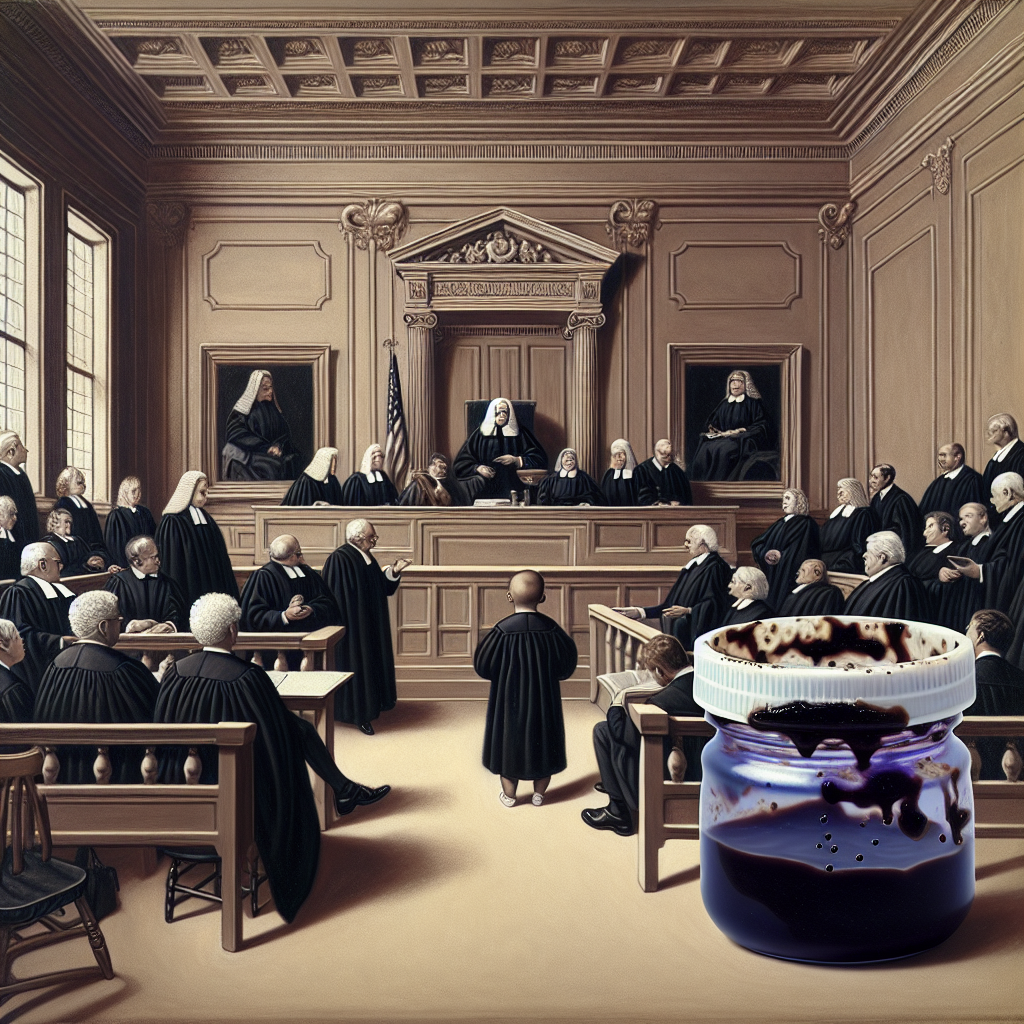The recent case of The Hain Celestial Group v. Palmquist has attracted significant attention due to its implications for procedural strategies in litigation. The Supreme Court justices convened to hear the arguments surrounding this case, which centers on allegations of toxic metals in baby food affecting a child’s health. The brevity of the proceedings, lasting under 45 minutes, indicates a focused discussion on the procedural elements rather than the substantive issues of the case itself.
Background of the Case
The origins of this litigation trace back to Sarah Palmquist, a Texas resident who contended that her child suffered harm due to the presence of toxic substances in baby food manufactured by The Hain Celestial Group. In her pursuit of justice, Palmquist’s legal team opted to file the lawsuit in Texas state court, a strategy rooted in the belief that state courts generally offer a more favorable environment for plaintiffs compared to their federal counterparts. This decision was further bolstered by the inclusion of Whole Foods as a co-defendant, a move intended to maintain jurisdiction within the state court system.
By suing both Hain, based in Delaware, and Whole Foods, a Texas-based grocery chain, Palmquist effectively removed the possibility of federal court jurisdiction under the diversity statute. This statute typically allows cases to be moved to federal court if the parties are from different states, a scenario that would have been applicable had only Hain been named as a defendant. The strategy was clear: keep the case in a state court where the odds might favor the plaintiff.
Procedural Maneuvering and Federal Court Transfer
Despite the initial procedural framework set by the state court filing, Hain successfully argued for a transfer to federal court. This transfer was predicated on the assertion that the claims against Whole Foods were insubstantial. The federal trial court ultimately agreed, dismissing Whole Foods from the litigation. This decision allowed the trial to proceed with only the diverse parties involved: Palmquist and Hain.
The trial concluded with a ruling in favor of Hain, as the court found no merit in Palmquist’s allegations regarding the baby food’s safety. However, the case did not end there; it escalated to the U.S. Court of Appeals for the 5th Circuit, which was tasked with reviewing the procedural decisions made by the federal trial court. The appellate court’s examination included the validity of the dismissal of Whole Foods and the appropriateness of the federal court’s jurisdiction over the remaining claims.
Implications for Future Litigation
The outcome of The Hain Celestial Group v. Palmquist could have far-reaching implications for future litigation involving similar claims. The case exemplifies the strategic considerations that plaintiffs must navigate when choosing their venue and defendants. As the justices deliberate, it is clear that their ruling will address not only the specifics of this case but also broader procedural standards that may influence how similar cases are litigated in the future.
Moreover, the case highlights the complexities involved in multidistrict litigation challenges and the tactical decisions that attorneys must make when formulating their approach. The justices’ comments during the hearing suggest a leaning towards affirming the lower court’s decision, which may set a precedent for how courts handle procedural issues in cases involving multiple parties and jurisdictional questions.

Legal professionals are keenly observing this case, as its resolution could inform the potential for future tort reform implications and the strategies employed in similar health-related lawsuits. As the legal landscape continues to evolve, the principles established in this case will likely resonate in courtrooms across the country.
The recent Supreme Court case of The Hain Celestial Group v. Palmquist has brought to light critical issues surrounding procedural strategies in litigation involving baby food contaminated with toxic metals. The case centers on a mother, Sarah Palmquist, who alleged that her child was harmed by the tainted food. As the justices heard arguments, they seemed poised to affirm the lower court’s decision, suggesting that procedural issues may ultimately overshadow the substantive claims of the case.
Understanding the Litigation Landscape
In this specific case, Palmquist’s legal team opted to file the lawsuit in Texas state court, as they believed it would provide a more favorable environment for plaintiffs compared to federal courts. This choice reflects a broader trend in litigation strategy, where attorneys often prefer state courts for certain types of claims. By including Whole Foods, a Texas-based grocery chain, as a co-defendant alongside Hain, the strategy effectively eliminated the potential for the case to be moved to federal court under diversity jurisdiction rules. This tactical decision was aimed at keeping the case in a venue perceived as more sympathetic to plaintiffs.
The procedural intricacies of the case became even more pronounced when Hain successfully transferred the litigation to federal court, arguing that the claims against Whole Foods were insubstantial. This maneuver raised significant questions about the legitimacy of the procedural tactics employed by Hain. The federal trial court dismissed Whole Foods from the case, allowing the trial to proceed with only Palmquist and Hain as parties. Ultimately, Hain emerged victorious, with the court dismissing Palmquist’s claims regarding the harmful effects of the baby food.
Implications of Procedural Decisions
The Supreme Court’s consideration of this case highlights the critical role that procedural decisions can play in the outcomes of litigation. The justices’ comments during the hearing suggested a recognition of the importance of maintaining the integrity of state court jurisdiction and the implications of transferring cases to federal courts. Such procedural battles can significantly impact the ability of plaintiffs to pursue their claims effectively.
As the legal community observes the developments in this case, it serves as a reminder of the need for careful consideration of litigation strategies. Decisions regarding where to file a lawsuit, which defendants to include, and how to frame claims can substantially influence the trajectory of a case. For those navigating the complexities of litigation, understanding the nuances of class action lawsuits and their procedural requirements is essential.

Moreover, the case underscores the potential risks associated with procedural missteps. When a case is moved from state to federal court, the dynamics of the litigation can shift dramatically, often to the detriment of the plaintiff. Legal professionals must remain vigilant about the implications of their strategic choices, particularly in high-stakes cases involving public health issues like contaminated baby food. The discussion surrounding this case also invites scrutiny of the legal risks social media may pose for plaintiffs, especially in terms of public perception and juror biases.
Looking Ahead
As the Supreme Court deliberates on the procedural aspects of this case, it is essential to consider the broader implications for future litigation. The outcome may set a precedent regarding the treatment of procedural matters in similar cases, influencing how attorneys approach the filing of lawsuits in state versus federal courts. Legal practitioners and scholars alike will be watching closely as the justices weigh in on these critical issues.
The case also emphasizes the importance of effective communication and advocacy during supreme court oral arguments. The justices’ relatively brief engagement with the arguments presented may reflect their inclination to focus on procedural correctness rather than the substantive claims of the case. This dynamic illustrates the complexities inherent in high-profile litigation and the necessity for legal professionals to be adept in both substantive law and procedural strategy.
The recent Supreme Court case involving The Hain Celestial Group and Sarah Palmquist has brought significant attention to the procedural intricacies of litigation, particularly in the context of state versus federal court jurisdiction. The justices’ brief hearing, lasting under 45 minutes, indicated a potential affirmation of the lower court’s decision, reflecting a streamlined approach to resolving procedural issues that often complicate legal proceedings. This case underscores not only the legal strategies employed by plaintiffs but also the judicial system’s response to procedural maneuvering.
Understanding the Case Background
At the heart of this litigation is a mother, Sarah Palmquist, who alleged that toxic metals present in baby food had adversely affected her child’s health. Her legal team opted for a state court in Texas, believing it to be more favorable for plaintiffs in such cases compared to federal courts. The strategy involved suing both the manufacturer, The Hain Celestial Group, and the local retailer, Whole Foods, to establish jurisdiction in state court. This dual-defendant approach was crucial, as it effectively negated the possibility of transferring the case to federal court under the diversity jurisdiction rules, which apply to parties from different states.

The inclusion of Whole Foods, a Texas-based company, was a strategic decision aimed at keeping the case within the more plaintiff-friendly environment of state court. However, Hain’s subsequent actions to transfer the case to federal court were predicated on their argument that the claims against Whole Foods were insubstantial. They succeeded in having the federal trial court dismiss Whole Foods from the litigation, thereby allowing the case to proceed solely against Hain, a Delaware corporation. This maneuvering raises critical questions about the balance of power between state and federal courts in handling cases involving diverse parties.
Implications of the Supreme Court’s Hearing
The Supreme Court’s engagement with this case signifies the importance of procedural clarity in litigation. During the hearing, the justices expressed minimal commentary, suggesting that they might uphold the lower court’s ruling. This outcome could reaffirm the ability of defendants to challenge the validity of claims against local entities to facilitate a transfer to federal court, which may lead to more favorable outcomes for defendants like Hain. The implications of this case extend beyond its immediate parties, as it may influence future litigation strategies employed by both plaintiffs and defendants.
Moreover, the case highlights the evolving landscape of litigation in the face of emerging technologies and legal frameworks. With increasing discussions surrounding the role of technology in legal processes, the implications of this case could resonate in future cases involving complex legal arguments and procedural challenges. For instance, the intersection of AI in courtrooms is becoming a relevant topic as courts grapple with the integration of advanced technologies in legal proceedings.
Future Considerations for Litigation
As the legal community awaits the Supreme Court’s decision, the case serves as a reminder of the importance of strategic planning in litigation. Plaintiffs must carefully consider the implications of their chosen jurisdiction and the potential for procedural challenges from defendants. The outcomes of such cases can set precedents that will shape litigation strategies for years to come, particularly in areas involving consumer safety and product liability.
Furthermore, the case illustrates the necessity for legal practitioners to remain vigilant about the procedural aspects of their cases. Understanding the nuances of jurisdictional rules and the potential for removal to federal court can significantly impact the trajectory of a lawsuit. As the legal landscape continues to evolve, staying informed about procedural developments will be crucial for attorneys navigating complex cases.